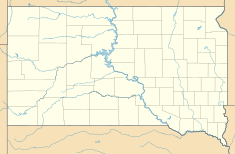Fort Randall Dam facts for kids
Quick facts for kids Fort Randall Dam |
|
|---|---|

Fort Randall Dam and Power Plant, with Lake Francis Case in the background.
|
|
|
Location of Fort Randall Dam in the State of South Dakota.
|
|
| Country | United States |
| Location | Gregory County and Charles Mix County, South Dakota. |
| Coordinates | 43°04′00″N 98°33′14″W / 43.066722°N 98.553897°W |
| Purpose | Flood Control, Hydroelectric Power, Irrigation, Water Supply, River Navigation, and recreation. |
| Status | Operational |
| Construction began | 1946 |
| Opening date | 1953 |
| Construction cost | $200 million |
| Owner(s) | |
| Dam and spillways | |
| Type of dam | Rolled-earth fill |
| Impounds | Missouri River |
| Height | 165 ft (50 m) |
| Length | 10,700 ft (3,261 m) (including spillway) |
| Spillways | 21 40-foot x 29-foot tainter gates |
| Reservoir | |
| Creates | Lake Francis Case |
| Total capacity | 5,418,000 acre⋅ft (6.683004596×109 m3) |
| Catchment area | 14,150 sq mi (36,648 km2) |
| Surface area | 102,000 acres (41,000 ha) |
| Maximum length | 107 mi (172 km) |
| Maximum water depth | 140 ft (43 m) |
| Normal elevation | 1,350 feet msl – 1,375 feet msl |
| Power station | |
| Operator(s) | U.S. Army Corps of Engineers |
| Website U.S. Army Corps of Engineers - Fort Randall Project |
|
The Fort Randall Dam is a huge earthen dam that stretches over 2.03 mi (3 km) across the Missouri River. It creates Lake Francis Case, which is one of the largest reservoirs in the United States. This dam connects Gregory and Charles Mix counties in South Dakota. It's located about 880 river miles (1,416 km) upstream from St. Louis, Missouri, where the Missouri River joins the Mississippi River. The U.S. Army Corps of Engineers built and still operates the dam and its power plant.
Contents
Building the Fort Randall Dam
The idea for Fort Randall Dam was approved in 1944 as part of a big plan to manage the water resources of the Missouri River basin. The U.S. Army Corps of Engineers started building the dam in 1946. It was the first dam in this major plan to be finished by the Omaha District of the Corps.
The dam was completed in 1956, and the whole project, including Lake Francis Case, cost about $200 million. In 1954, President Dwight D. Eisenhower himself flipped the switch to start the first power-generating unit! You can even drive across the top of the dam on U.S. Route 18 and U.S. Route 281. The dam is just over 3 mi (5 km) north of the Nebraska state line.
The Fort Randall Dam is named after Fort Randall, an old U.S. Army outpost. It's one of six main dams on the Missouri River. Upstream from Fort Randall Dam is Big Bend Dam, and downstream is Gavins Point Dam.
How Fort Randall Dam Makes Electricity
The Fort Randall Dam has eight large machines that make electricity. Each one can create 40 megawatts of power. Together, they can produce a total of 320 megawatts. This is enough electricity to power about 245,000 homes!
The water behind the dam, in Lake Francis Case, covers a huge area of 102,000 acres (41,000 ha) when it's full. This massive amount of water is used to spin the turbines and generate clean energy.
The Big Flood of 2011
In June 2011, there was a very big flood on the Missouri River. To help control the floodwaters, the Fort Randall Dam had to release a huge amount of water. It let out over 143,000 cubic feet per second (4,000 m3/s) of water. This was a new record, much more than its previous record release of 67,000 cu ft/s (1,900 m3/s) in 1997. This shows how important the dam is for flood control.
Visiting the Dam
If you want to learn more about the Fort Randall Dam, you can visit the Fort Randall Visitor Center. It's located on the western edge of Pickstown, South Dakota, right along U.S. Highway 281 and 18.
The visitor center is open from Memorial Day through Labor Day. From there, you can get a great view of the Fort Randall Dam, Lake Francis Case, and the Missouri River. Inside, you'll find cool exhibits about how the dam was built, the history of the area, and even some fossils! There's also a freshwater aquarium where you can see different kinds of fish that live in the Missouri River.


